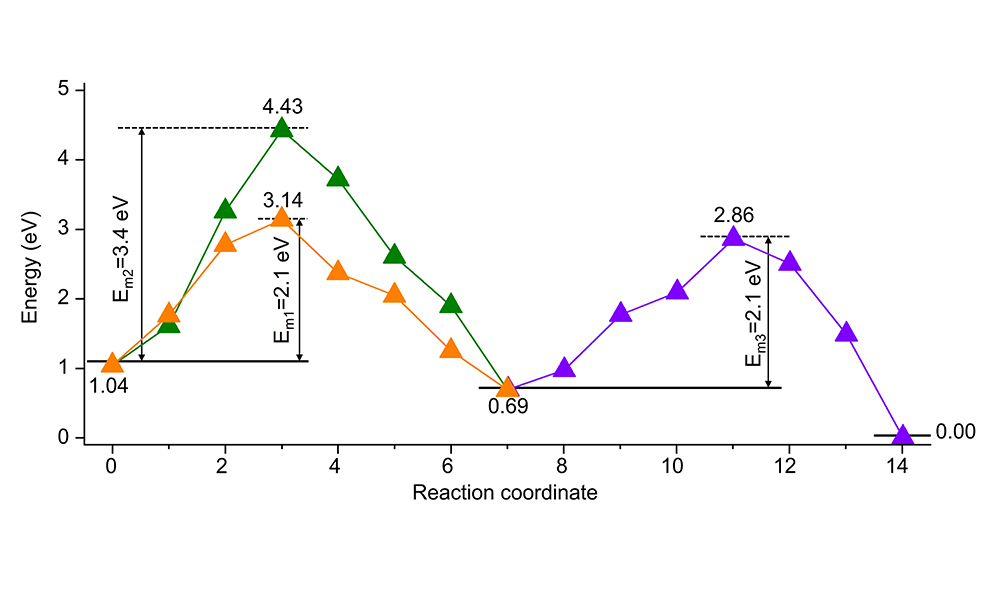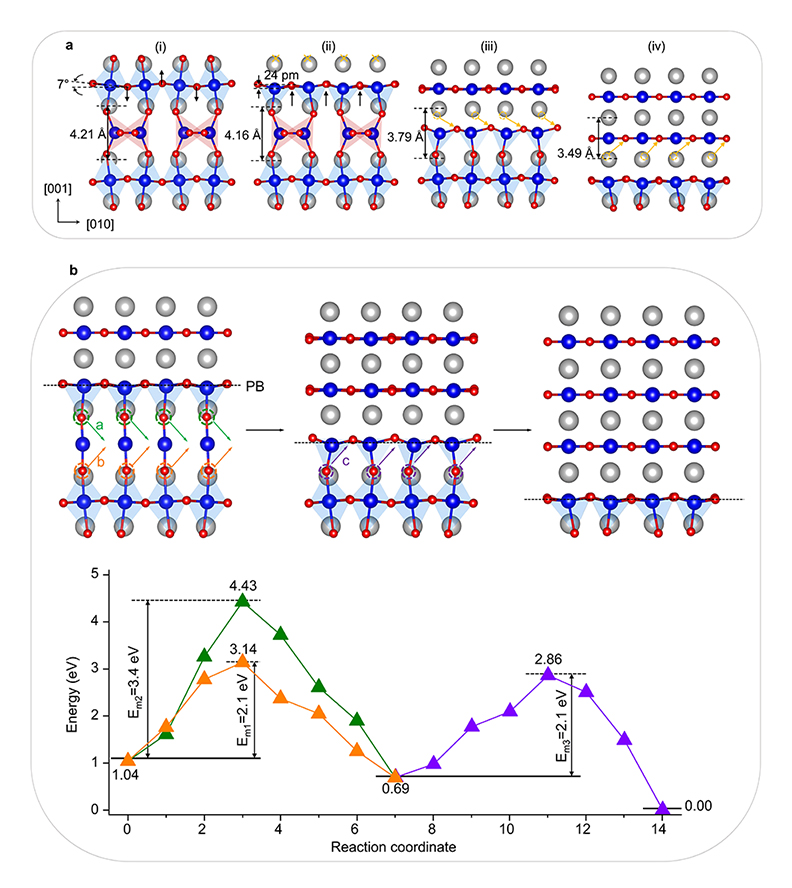
PNU 리서치
- 메인으로 이동
- 연구/산학
- PNU 리서치

물리학과 이재광 교수 연구팀은 성균관대·한국에너지공대와의 협력연구를 통해 새로운 양자물질로 활용 가능한 층상형 전이금속 산화물 형성의 메커니즘을 원자 수준에서 규명했다.
일반적으로 전이 금속은 산소와 3차원 결합을 선호한다. 산소 6개와의 결합을 통해 3차원 팔면체 구조(octahedral structure), 산소 4개와의 결합을 통해 3차원 사면체 구조(tetrahedral structure)를 형성한다. 이에 비해 2차원 평면 구조 (planar structure)는 3차원 구조보다 불안정한 것으로 보고돼 왔다.
그럼에도 2차원 형태의 층상형 전이 금속 산화물은 초전도 발현의 근간으로 알려져 있다. 나아가 2차원 층상 구조에 따른 전이 금속 내 강한 자기 이방성(magnetic anisotropy)은 기존 산화물에서는 나타나지 않는 새로운 양자 특성들을 발현시킬 것으로 기대되고 있다.
이에 에너지적으로 불안정한 2차원 층상형 전이 금속 산화물 형성 메커니즘을 규명하는 것은 층상 산화물에 기반한 새로운 양자물질 및 양자소자 개발에 핵심적인 연구 분야로 주목받고 있다.
이번 연구에서 이재광 교수팀은 전자구조 계산과 분자 동역학 시뮬레이션을 통해 2차원 형태의 층상 구조가 어떤 식으로 형성되는지, 원자 수준의 산소 원자들의 재배열과 에너지 분석을 통해 밝혀냈다.
연구에 참여한 성균관대 연구팀은 3차원 형태의 고품질 SrFeO2.5 에피 박막을 구현했고, 한국에너지공대 연구팀은 3차원 SrFeO2.5에서 2차원 형태의 층상 구조 SrFeO2로의 변화를 전자 현미경으로 실시간 이미징했다.

【층상형 산화물 전환 과정에서 산소 원자들 재배열 및 관련 에너지 계산】
연구팀은 3차원 구조 내 위와 아래 부분에 위치한 산소(apical oxygen)들이 평면에 위치한 산소(equatorial oxygen)들에 비해 상대적으로 쉽게 본래 위치에서 벗어난다는 것을 밝혔고, 이들이 다른 층 전이금속의 평면층으로 이동해 재배열을 통해 2차원 층상 구조가 형성됨을 관찰했다. 이러한 산소원자들의 다른 층으로의 이동과 평면층에서의 재배열이 반복되며 2차원 층상구조가 확장됨을 원자 수준에서 규명했다.
이재광 교수는 “이번 연구는 전이금속 Fe(철) 기반 층상 산화물 형성 메커니즘을 원자 수준에서 규명한 것으로, 향후 Ti(티타늄), V(바나듐), Mn(망간), Co(코발트), Ni(니켈) 등 다른 전이금속 기반 층상 산화물 구현의 길을 제시했다. 이는 2차원 층상 산화물에 기반한 새로운 형태의 양자소자 개발 개발에 핵심자료가 될 수 있을 것으로 기대된다”고 말했다.

【왼쪽부터 이재광 교수, 김인환 석사 졸업생】
이번 논문은 부산대 물리학과 김인환 석사 졸업생(현 UT Austin 물리학과 박사과정)이 제1저자, 이재광 교수와 성균관대 최우석 교수, 한국에너지공대의 오상호 교수가 공동교신저자로 수행해, ‘Monitoring the formation of infinite-layer transition metal oxides through in situ atomic-resolution electron microscopy(층상형 전이금속 산화물 형성 메커니즘 규명)’이라는 제목으로 국제학술지 『Nature Chemistry』 8월 27일자에 게재됐다.
- 논문 링크: https://www.nature.com/articles/s41557-024-01617-7
해당 연구는 과학기술정보통신부 중견연구자지원사업의 지원을 받았다.
[Abstract]
Infinite-layer transition metal oxides with two-dimensional oxygen coordination exhibit intriguing magnetic properties due to strong in-plane orbital hybridization. The synthesis of this distinctive structure has primarily relied on kinetically controlled reduction of oxygen-rich phases featuring three-dimensional polyhedral oxygen coordination. Here, using in situ atomic-resolution electron microscopy, we scrutinize the intricate atomic-scale mechanisms of oxygen conduction leading to the transformation of SrFeO2.5 to infinite-layer SrFeO2. The oxygen release is highly anisotropic and governed by the lattice reorientation aligning the fast diffusion channels towards the outlet, which is facilitated by cooperative yet shuffle displacements of iron and oxygen ions. Accompanied with the oxygen release, the three-dimensional to two-dimensional reconfiguration of oxygen is facilitated by the lattice flexibility of FeOx polyhedral layers, adopting multiple discrete transient states following the sequence determined by the least energy-costing pathways. Similar transformation mechanism may operate in cuprate and nickelate superconductors, which are isostructural with SrFeO2.
* Reference (Pusan National University)
- Authors: Inhwan Kim, Prof. Jaekwang Lee (Department of Physics)
- Title of original paper: Monitoring the formation of infinite-layer transition metal oxides through in situ atomic-resolution electron microscopy
- https://www.nature.com/articles/s41557-024-01617-7
- Journal: Nature Chemistry
- DOI: 10.1038/s41557-024-01617-7
